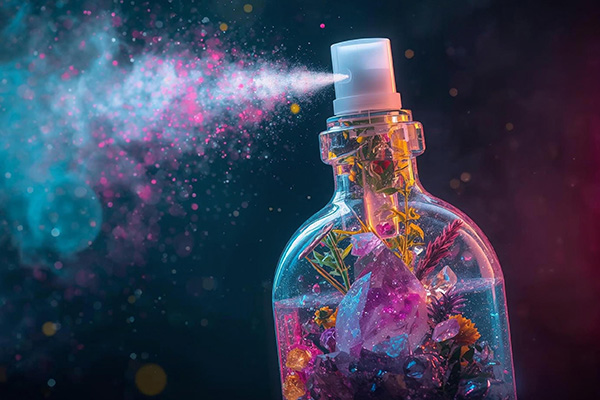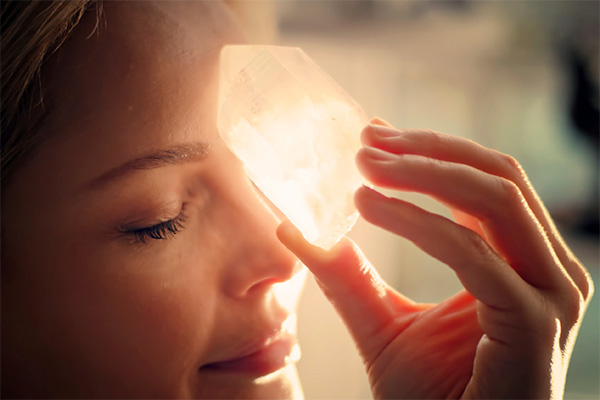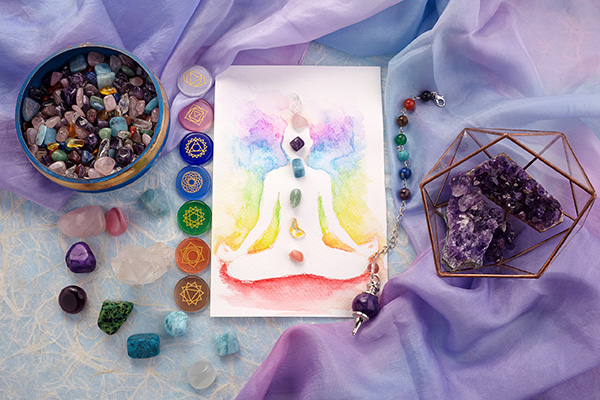crystal healing
Create Your Own Energy Cleansing Spray
 Remember the last time you changed out a dirty air filter from your air-conditioning unit, vacuum cleaner, or your car? Remember how clogged with dust it was? In our living spaces, negative energies accumulate over time just like those ‘dust bunnies.’
Remember the last time you changed out a dirty air filter from your air-conditioning unit, vacuum cleaner, or your car? Remember how clogged with dust it was? In our living spaces, negative energies accumulate over time just like those ‘dust bunnies.’
Even though we can’t see these energies, there is a way to clear them on a regular basis. Think of it as the spiritual version of house cleaning.
Just as we’re drawn to refresh our surroundings with a good spring clean, our homes and sacred spaces crave energetic renewal, too.
Energies from arguments, stress, illness, or even just the daily grind can leave behind subtle residue. This energetic debris doesn’t vanish on its own. Left unchecked, it can affect your mood, your sleep, and even the flow of abundance into your life.
The first and most obvious step to take is to physically clean your space. Clutter and unwanted items work as repositories for negative energy, so it’s important to get rid of it.
After you’re done, imagine the space being deep-cleaned with an indigo or violet-colored flame. Use this as a silent meditation, and picture the flames consuming all that invisible ‘dust.’
And, just like your body or your car, your space can be cleansed and cleared of obstructions.
The easiest way to do this is to create a personal essential oil blend, which can be sprayed throughout your office and home. If made right, these smell wonderful, although their main purpose is for energy clearing and not aromatherapy.
Here’s what you’ll need to make your very own space-clearing spray blend. The ingredients can be purchased at an herbal supplies or natural products store.
End Of Year Moon And Crystal Energy Work
 As the days shorten and the year moves toward its close, the moon’s energy becomes an even more potent ally for reflection, release, and new beginning.
As the days shorten and the year moves toward its close, the moon’s energy becomes an even more potent ally for reflection, release, and new beginning.
The final months of this year is a powerful time deepen our relationship with lunar cycles and use crystal allies to support our inner work.
The moon acts as a mirror to our inner landscape. Its cycles guide our rhythm: the new moon beckons us to plant seeds, while the full moon calls us to release what no longer serves. When we intentionally pair lunar awareness with crystal work, we amplify our clarity, access intuition, and align with energies that support transformation.
I once worked with a university professor who, at the cusp of year’s end, felt fragmented by multiple obligations. During a full moon session, we guided her to sense what needed release, using amethyst for clarity and calm. As she held it and journaled, she relinquished projects that drained her energy and discovered space for a new creative initiative born of her deeper passion.
Another client, an actor, had endured months of stagnation in auditions. We chose a new moon moment to plant intentions. He carried citrine to boost confidence and attract aligned opportunities. As he remained intentional through the lunar cycle, his energy shifted…not from anxious striving, but from grounded authenticity. Soon after he landed a role that felt perfectly right!
A Beginner’s Guide To Holistic Healing
 True healing is about more than just easing lower back pain or calming anxious thoughts. It’s about supporting the “whole you” so you can live in greater balance, joy and peace.
True healing is about more than just easing lower back pain or calming anxious thoughts. It’s about supporting the “whole you” so you can live in greater balance, joy and peace.
It means caring for the body, the heart, the mind, and the soul. While each of these areas can be worked on separately, the deepest transformation happens when they’re all supported together. That’s the essence of holistic healing.
For many people who are new to holistic healing, it can seem complex, mysterious, or even intimidating. Often, there’s curiosity, but also uncertainty about where to begin, especially if they’ve never tried it before.
Some worry they’re not knowledgeable enough, or believe it’s something only meant for people with special spiritual insight or advanced esoteric understanding. Others may wonder if they’ll “do something wrong” or fear they won’t understand what’s happening during a session.
These feelings are completely normal, but they can hold you back from exploring something that could be deeply supportive and life-changing.
The truth is, holistic healing doesn’t have to be complicated or overwhelming. You don’t need to know every technique or understand all the details to benefit from it. An experienced healer will help you find the best route, even if you’ve never walked the path before.
If you’ve never had a holistic healing session, here’s what often happens: You might arrive thinking you need one specific kind of support, but a skilled healer will take time to tune in and see what you truly need most. Sometimes they’ll use the method you requested, and other times they may suggest a different approach, or even combine several techniques, to support you in the best possible way. The aim isn’t just temporary relief; it’s to start you on a healing journey you can continue long after the session ends.
Balance Your Mind With Crystal Energy
 The human brain is a dual force, with the left and right hemispheres complementing each other to create a balanced mind.
The human brain is a dual force, with the left and right hemispheres complementing each other to create a balanced mind.
Each side of the brain brings its own gifts to the whole, working together to shape our unique perceptions and experiences.
The left brain is known for its logical, structured, and analytical approach to processing information, excelling in tasks like reasoning, mathematics, and language.
In contrast, the right brain is more intuitive, imaginative, and emotionally expressive, fueling creativity, visual thinking, and spiritual insight.
This division of cognitive function influences how we think, solve problems, and interact with the world, both internally and externally.
In the realm of energy work and healing, various crystals and stones support and enhance the natural strengths of each brain hemisphere, promoting overall mental and emotional harmony and balance.
Whether you are seeking increased focus for problem solving or a boost in artistic expression, the right combination of crystals can support a harmonious mind that fosters both intellectual and creative growth.
By setting clear intentions and using the appropriate crystals and stones regularly, you can harness their energies to align both hemispheres of the brain and promote an integrated approach to life.
In this sacred balance, the mind and soul find unity, creating a deeper sense of wholeness and fulfillment—a fusion of logic and intuition, structure and flow, thought and feeling.
Practical Techniques For Psychic Protection
 Psychic protection, also known as spiritual or energetic protection, is a practice I hold dear because it helps shield me from negative energies, psychic attacks, and unwanted influences.
Psychic protection, also known as spiritual or energetic protection, is a practice I hold dear because it helps shield me from negative energies, psychic attacks, and unwanted influences.
The concept is not new. Mystical protection practices can be traced back to various ancient civilizations, indigenous traditions, Eastern philosophies, and Western esoteric practices.
In ancient Egypt, Greece, and Rome, amulets and talismans were worn and protective deities invoked to ward off negative energies and evil spirits. Indigenous cultures in the Americas and Africa used smudging and rituals to summon ancestral spirits for protection.
Eastern religious traditions such as Hinduism and Buddhism use mantras, yantras, and meditation for spiritual protection. Kabbalistic traditions emphasize the use of specific prayers and rituals to create spiritual shields. These practices reflect a deep-rooted belief in the power of divine intervention and sacred symbols to provide protection.
In Catholicism, believers recite prayers such as the Lord’s Prayer or the prayer to St. Michael for protection from evil. They may also use holy water, crucifixes, or medals of saints as protective symbols. In Judaism, the recitation of Psalms and the use of amulets inscribed with Hebrew verses are common practices for protection against negative influences.
Contemporary spiritual communities have adapted these ancient practices to include the use of crystals, energy healing, and visualization techniques. Workshops, books, and teachings offer a wealth of methods for psychic protection, all aimed at maintaining a balanced, protected, and positive state of being. These diverse traditions and modern adaptations underscore the universal spiritual need to protect ourselves from unseen negative energies and dark influences.
Energize Your Chakras With Lithotherapy
 Lithotherapy, also known as crystal healing, is a popular alternative healing method for improving physical, emotional, mental and spiritual well-being.
Lithotherapy, also known as crystal healing, is a popular alternative healing method for improving physical, emotional, mental and spiritual well-being.
But lithotherapy is far from a modern trend. This healing modality has its origins in ancient civilizations, and many indigenous cultures around the world have traditionally used stones and other natural elements in their healing practices, rituals and ceremonies.
Derived from the Greek words lithos (stone) and therapeia (healing), this ancient art harnesses the energies of crystals, stones and minerals that interact with the human energy field to promote energy flow, alignment and balance.
Lithotherapy uses the natural energies of the earth for a holistic approach to healing without the use of synthetic chemicals or man-made materials.
Today, lithotherapy is a staple of alternative medicine and energy healing, and the practice has gained widespread popularity in recent years as more people now incorporate crystals and stones into their lifestyle and spiritual practice.
Each crystal has unique metaphysical properties, allowing practitioners to choose stones that resonate with their specific needs and intentions. One of the most common uses is chakra energy work to clear, balance, and align the body’s energy centers, known as the chakras.
Each of the chakras corresponds to specific physical, mental, emotional or spiritual aspects of our being, and certain crystals, stones and minerals resonate with each of these energy centers to help restore energy flow, function, balance and wellness.
End Your Day With A Restorative Evening Ritual
 How we end our days is just as important as how we begin them. Yet this time of the day is often overlooked as an opportunity to promote our personal and spiritual well-being.
How we end our days is just as important as how we begin them. Yet this time of the day is often overlooked as an opportunity to promote our personal and spiritual well-being.
Especially when navigating stressful situations or busy schedules, being intentional about how we transition into rest can significantly improve the quality and restorative nature of our downtime.
Creating a simple, personalized nighttime routine allows us to check in with ourselves and make sure we’re taking care of our mind, body, and spirit. It helps relieve the stress of the day and sets the tone for a restful night’s sleep.
There are countless ways to create an evening ritual or routine that resonates with your spirit. The important thing is that your practice feels authentic and meets your needs. It only takes a few simple steps to create a daily practice that helps us release the stress of the day.
Whatever practice you choose, make sure it works with your schedule and is relaxing, rather than feeling like it creates more daily tasks to complete.
Choose activities that help you relax and that you look forward to. Whether it’s journaling, listening to soothing music, or lighting a candle, choose activities that help you intentionally transition from the busyness of the day to the calm of the night.
Many people complain that they don’t have enough time in their day. For them, a daily spiritual routine is a frivolous luxury they cannot afford to waste time on, yet these same people often spend hours each night binge-watching television or endlessly scrolling through their phones. This modern paradox highlights how easily we prioritize mindless distractions over meaningful self-care. By consciously reclaiming even a fraction of this time, we can nurture our spiritual well-being every evening in a way that renews our body, mind, and spirit far more effectively.